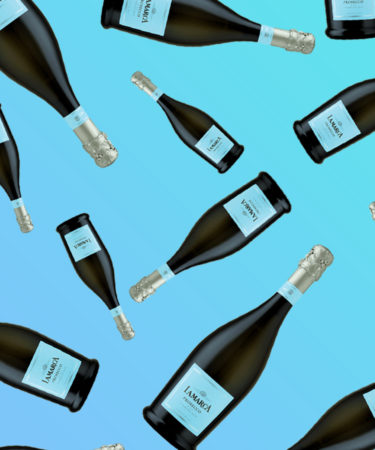Prosecco is all about approachability. The fruity, fresh sparkling wine pairs as well with food as it does an afternoon by the pool, and makes a classy yet affordable Mimosa. Of course, there’s more to Prosecco than its easy likeability; and La Marca is a brand to get to know it by.
La Marca produces the two major types of Prosecco. It uses the sparkling style’s marquee grape; and the brand embraces the levity of the Prosecco lifestyle without losing its roots in one of Italy’s most iconic winemaking traditions. Here are nine more things to know about La Marca Prosecco.
La Marca is not a winery; it’s nine wineries.
Sometimes, like the guy who invented the Choco Taco, you have a good idea for a product, you make it. When you’re a winery looking to put your grapes into a bottle, behind a brand, you might not always have sufficient product — hence you have wineries joining forces, and grapes, forming cooperatives that very literally pool their juices to produce one brand. La Marca is the umbrella brand of nine wineries that joined forces (and so cut costs, organized resources, etc.) in the Veneto and Friuli-Venezia-Giulia regions.
La Marca’s wines are made with a grape synonymous with ‘Prosecco.’
Glera is actually the main grape in any Prosecco, including La Marca. If we’re getting technical, Glera is a synonym for the Prosecco grape, which was ultimately renamed just Glera (and is also multiple grapes). That change came in late 2009, when a region within the Prosecco region was named a DOCG and it became much more important to keep the “Prosecco” name pure (see below for more on DOC vs. DOCG).
Stressed Glera makes easy, breezy bubbly.
Glera grapes get a bit dull when they live the easy life on flat land (think of the movie protagonist pre-workout montage/definitive conflict). However, like most any wine grape, when the variety is grown on sloping ground (and so has better drainage and inconstant sun exposure — a good thing, trust us), Glera develops different characteristics. In general, the flavor is brightly acidic and generously aromatic, with lots of soft stone fruit flavor (think white peach skin), some honey notes, and a bit of clean citrus (i.e., not a Lemonhead, more like the citrus in that massive bar of lemon rosemary soap you almost impulse buy at HomeGoods).
La Marca is a great way to get to know Prosecco levels.
La Marca does two Proseccos — their basic and the Luminore, a “Prosecco Superiore.” If you buy a bottle of each you can teach yourself about the evolution of Prosecco wine. See, Prosecco isn’t just a crisp, clean, dangerously easy-drinking good time. It’s actually a complex wine with a fairly distinctive production method (see below) and genuine variety when it comes to nuance of expression. And production standards between the DOC and DOCG varieties make for a price difference of about $10 more for the Superiore. (The ABV is the same — 11 percent for both.)
What makes it ‘Superiore’ is (mostly) production region.
La Marca’s flagship Prosecco is from the Prosecco D.O.C., which is a region in northeastern Italy. Their Luminore is from the Conegliano Valdobbiadene D.O.C.G., a smaller region within the region that’s subject to stricter standards (since 2009). Among those stricter standards is, of course, location, but also a required higher percentage Glera grapes in the overall product (if a winemaker is inclined to blend), and lower yields of the grapes themselves (a vine with lower yields tends to produce more interesting grapes). The finished Proseccos have a slightly heavier mouthfeel in the Superiore region, with more apple notes, and even creamy peach, as well as zippy citrus that licks your palate clean (metaphorically).
Speaking of ‘zippy,’ it’s made using the ‘Charmat’ method.
The Charmat method may sound like a forthcoming HBO series about the non-traditional methods of an eccentric psychiatrist, but it’s actually just the way Prosecco gets made. In this method, wine undergoes secondary fermentation in large stainless steel tanks, as opposed to the traditional method, in which it ferments a second time in the bottle. The name refers to one of the two inventors of the method, Eugene Charmat, who improved on the tank method invented by Federico Martinotti. There’s less contact with the “lees” (or dead yeast cells) in this method, yielding less toasty bread tastes and more fresh fruit flavors, aromatics, and acidity.
La Marca’s label has a signature color, like Tiffany’s.
Not so much that you’ll feel the impulse to say “yes, yes, a thousand times yes” to a glass of La Marca Prosecco, but the soft eggshell blue color on the small La Marca label (and other packaging) is similar enough to the signature Tiffany Blue to confuse, delight, and cause a Pavlov-esque flop sweat response in anyone whose relationship is nearing that “rock” stage.
Celebrities like Rachel Bilson want you to love La Marca — and love yourself.
Who better than doe-eyed Summer Roberts of the O.C. to help usher in the #Celebreaks campaign? It sounds like celebrating a good session in one of those recreational demolition rooms, but it was actually a pretty nice marketing campaign aimed at encouraging everyone, especially women, to celebrate life’s everyday successes ”like taking a bath or just going to the market by yourself” — ideally with tiny bottles of La Marca bubbly in hand.
La Marca inspires poetry.
La Marca has been recognized as many things. Among the many consumer reviews of La Marca is one that’s particularly poignant: “A soft way to forget.” We assume they mean, forget the stress of the day, and responsibly enjoy your sparkling afternoon.


